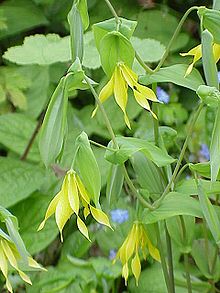Uvularia grandiflora
| Uvularia grandiflora | |
|---|---|

| |
| Flowers of Large-flowered Bellwort | |
| Scientific classification | |
| Kingdom: | |
| (unranked): | |
| (unranked): | |
| Order: | |
| Family: | |
| Genus: | |
| Species: | U. grandiflora
|
| Binomial name | |
| Uvularia grandiflora | |
Uvularia grandiflora (large-flowered bellwort or merrybells) is a species of flowering plant in the family Colchicaceae, native to eastern and central North America.
Range
The native range of Uvularia grandiflora extends from the Appalachians west to the Dakotas, Kansas and Oklahoma, from Louisiana and Georgia in the South to Manitoba, Ontario and Quebec in Canada. So, it widespread across the eastern mountains, the Great Lakes and the Mississippi Valley. There are also isolated populations along Chesapeake Bay in Maryland.[1]
Description
Growing to 75 cm (30 in) tall by 30 cm (12 in) broad, it is a rhizomatous herbaceous perennial with pendent leaves which are hairy on the undersides. It blooms in mid- to late spring, producing large yellow, solitary or paired, bell-shaped, pendent flowers.[2] The top parts of the plant tend to bend downward due to the weight of the leaves and flowers. The light green stems are round, glabrous, and glaucous and the leaves are perfoliate since the stem appears to come through the leaves at the base.
This plant differs from Uvularia sessilifolia in that the leaves of the latter grow from the stem and its flowers are smaller. U. grandiflora also differs from Uvularia perfoliata, which occurs in eastern North America. The latter has similar large perfoliate leaves, but the flowers have orange-coloured bumps on the petals.
Cultivation
Uvularia grandiflora has gained the Royal Horticultural Society's Award of Garden Merit.[3] There exists a cultivar 'Pallida' with paler coloured flowers.[4]

Bumblebees, Mason bees, Halictid bees, and Andrenid bees feed from the nectar and collect pollen from the flowers. Deer love to eat these plants.
Ecology
In fall (autumn) three capsuled ovaries can be observed on some individuals. The seeds have attached food bodies (elaiosome) making it attractive to ants for the redistribution of the seeds.
References
- ^ "Uvularia grandiflora Sm". USDA PLANTS.
- ^ RHS A-Z encyclopedia of garden plants. United Kingdom: Dorling Kindersley. 2008. p. 1136. ISBN 1405332964.
- ^ "RHS Plant Selector - Uvularia grandiflora". Retrieved 7 June 2013.
- ^ Bourne, Val. "Merrybells". Daily Telegraph. Retrieved 4 May 2013.
